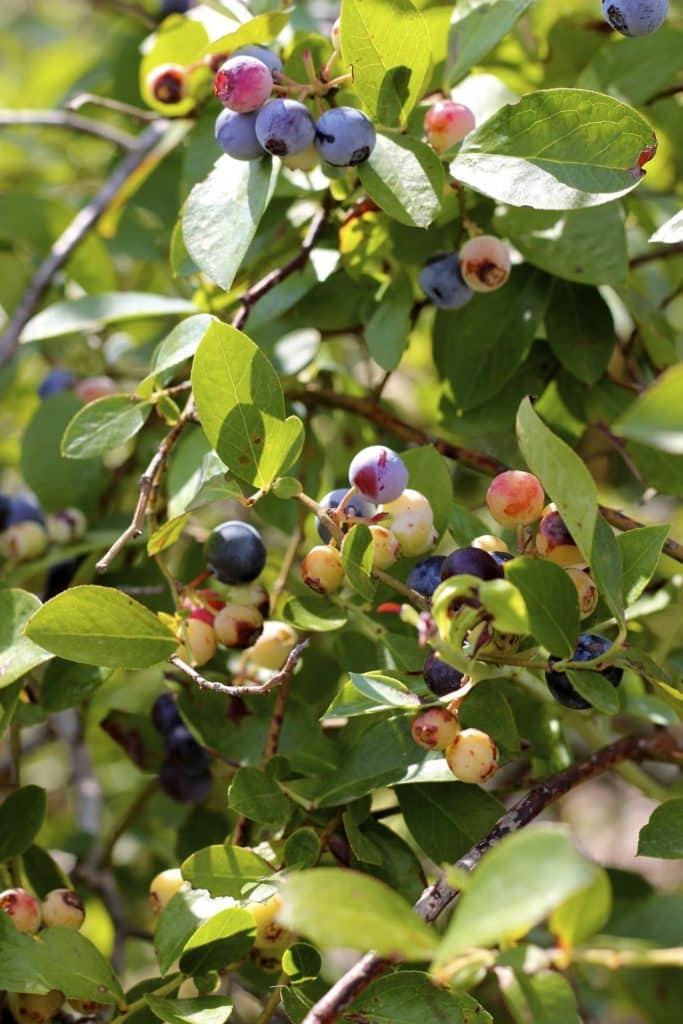As kids growing up in the late 1960s and early 1970s in rural Massachusetts, I and my three sisters spent many happy hours roaming a nearby forest and snacking on wild blueberries. We’d come home after a day of foraging with blue tongues, mouths and fingers, grinning from what was no doubt an antioxidant high inspired by Mother Nature’s bounty.
Today I live in Southern California, where the alkaline soil isn’t hospitable to this acid-loving berry bush, but I am able to enjoy a blueberry bounty by growing them in containers. That means you can experience the sweet goodness of homegrown blueberries, no matter where you live.
Now is the time to plant blueberry bushes. Follow these tips for growing your own delicious, antioxidant rich berries.
Plant in full sun. Blueberries require a location that receives sun most of the day. Opt for a location that gets sun until at least 2 or 3 pm.
Provide acidic soil. The soil pH for successful blueberry growing should be around 5.0. If the blueberry bush is grown in more alkaline soil, the plant will fail to thrive and won’t fruit. Signs that the soil is too alkaline include yellowing and dropping foliage, which is caused by the plant’s inability to take up sufficient iron.
If you are unsure of the pH of your soil, perform a soil test. Most university cooperative extension offices perform soil testing, as do soil laboratories. Or you can do your own test by using a soil test kit purchased from your local nursery.
 (Julia Freeman-Woolpert/Freeimages.com)
(Julia Freeman-Woolpert/Freeimages.com)
Amend. To create a soil that is hospitable to blueberry bushes, amend with homemade or bagged compost and soil sulfur. Sulfur lowers the pH of the soil. Before planting, wait two weeks and retest the soil in order to ensure that the pH is at the correct level for growing blueberries.
Blueberries also require good drainage, so amending with compost will help to keep things draining well.
Plant carefully. Place blueberries in the soil at exactly the same depth as they’ve been growing in their nursery containers. Top-dress the soil with a thin layer of compost.
Grow in a container. If your native soil is naturally alkaline, rather than fight Mother Nature, plant blueberry bushes in pots in a mix of pure peat moss with one part pumice or perlite and one part worm compost.
 (Kelsey Johnson/Freeimages.com)
(Kelsey Johnson/Freeimages.com)Plant more than one variety. In order to flower and fruit successfully, blueberries require that you plant at least two different varieties. The cross pollination will ensure fruiting and increase yield.
Keep well watered. Blueberries are shallower rooted than many shrubs, so it’s important to maintain moist but not soggy soil during flowering and fruiting. Water in the absence of rainfall when the top inch of soil has dried out.
Fertilize in early spring. When the plant begins to break dormancy, feed with an organic fertilizer, such as a 10-10-10 or a 10-5-5, which will lead to strong growth and abundant flowering and fruiting. Prior to planting, add an organic starter fertilizer to the soil.
Prune. Refrain from cutting a blueberry bush back until its third year. After the plant finishes fruiting at that point, trim back by one-third, removing the oldest, dark colored branches. Prune to open the bush up and shape it.
Julie Bawden-Davis is a garden writer and master gardener, who since 1985 has written for publications such as Organic Gardening, The American Gardener, Wildflower, Better Homes and Gardens and The Los Angeles Times. She is the author of seven books, including Reader’s Digest Flower Gardening, Fairy Gardening, The Strawberry Story Series, and Indoor Gardening the Organic Way, and is the founder of HealthyHouseplants.com.

